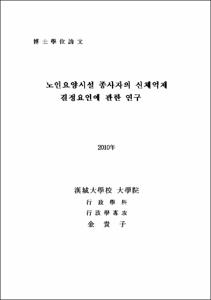노인요양시설 종사자의 신체억제 결정요인에 관한 연구
= A Study on the Determinants of Worker's Decision on Physical Restraint for the Aged People in Nursing Home
- Files in This Item:
-
-
Download
 000000563764.pdf
기타 데이터 / 81.75 MB / Adobe PDF
000000563764.pdf
기타 데이터 / 81.75 MB / Adobe PDF
-
Items in Repository are protected by copyright, with all rights reserved, unless otherwise indicated.